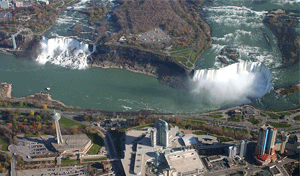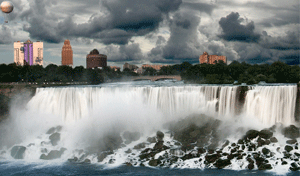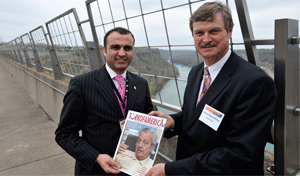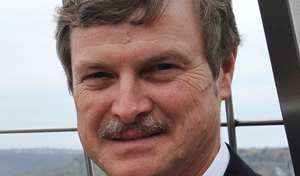City of Niagara Falls Builds on the Past, Seeks a Brighter Future
- Written by Admin TOA
- Published in Politicians

Niagara Falls, NY - What is the similarity between being a mayor of the City that is one of the U.S.’s top ten tourist destinations and being a professor of international affairs at a university? The best person to answer that question may be Paul A. Dyster, the mayor of Niagara Falls.
He is not an ordinary politician who spent a lot of time building a political career through political campaigns. After earning a doctorate from Johns Hopkins in Baltimore, Maryland, he settled in at Catholic University of America in Washington, D.C., where he eventually rose to become Director of the Graduate Program in International Affairs. For five years, he taught international relations to graduate and undergraduate students. He won the Niagara Falls mayoral election and took office in January 2008.
He said that some people say he is overqualified for the office, but he doesn’t think that way. The city receives many visitors from all over the world but now needs more investors for its empty old manufacturing buildings, because most of manufacturing plants closed or moved away, or some of them have been converted to manufacture other products.

Niagara Falls' current development strategy is focused on a pragmatic approach to revitalizing vacant and underutilized buildings in the downtown area as high profile catalyst projects with real economic impact.
Niagara Falls doesn’t have many Turkish people but Niagara University has two academicians of Turkish descent; Mustafa Gokcek, Assistant Professor of History Department and Murat Demirbas, Assistant Professor of Department of Computer Science and Engineering.
Niagara Falls Mayor Dyster says; “Niagara Falls is on some people’s list of places that they have to see before they die. Istanbul is my place to see before I die.” Besides seeing Istanbul, he wishes to see some Turkish investors in his town as well. Mayor Dyster answered TURKOFAMERICA’s questions.

Could you tell us why the city of Niagara Falls is important for investors?
Niagara Falls is one of the larger small cities in the New York State with a permanent residential population of around 55,000 individuals but it’s a very unique city in terms of economic opportunities. We usually get approximately 6-8 million visitors each year.
It’s a relatively small city market in terms of residence, but there are economic opportunities here in the tourism industry based on the large number of visitors. In terms of where customers come, from there is virtually no country in the world that doesn’t have people visiting Niagara Falls. The most densely populated, fastest growing regions of Canada are those located directly across the border, what we call the “Golden Horseshoe” which extends south from Toronto, Ontario. We are at the western end of New York State and of course we have this orientation toward New York City, but it is also the case that 1.5 hours to the north we have this great expanding metropolis of Toronto in Ontario. In the global economy we’re very well situated in between the two centers of population in North America. There’s also a very large portion of population of the U.S. located in the northeastern part of the country. That means Niagara Falls is within a few hours drive of Cleveland, Pittsburg and many other urban areas. Being located in the midst of your potential market becomes more and more important.
In the past chemical, steel, and manufacturing plants were very strong in Niagara Falls. What is the current position of those industries?
There are two traditional industries broadly found in Niagara Falls’ economy: Petrochemicals and steel. Two things happened. The first thing is a decline in competiveness of those industries over time. In some cases they redefined themselves. In other cases, a factory was opened for one purpose and now it’s been reopened for other purposes. Some of the companies that have been located here for some time are now manufacturing new types of products.

Can you give some examples for those companies?
For example, one of the large employers for many years in the area was the Carborundum Company. The company made braces for grinding wheels. Today the company is called Saint Gobain, it’s a subsidiary of a French company. It’s manufacturing among other things high tech low mass armor plating for both personnel protection and for armored vehicles. The same process used to manufacture armor plating is also used to manufacture other industrial components requiring a high degree of strength, very low weight, and a high degree of precision manufacture. That’s a example of a company totally transforming what it is doing within the same ownership structure.
We have also some large companies that are still in the same industry, but the industry has gone through some changes. Praxair is one of them. It’s a large industrial gas manufacturing company located in Taiwan and Niagara Falls. They are a major player in the hydrogen industry, which is becoming far more important than it was before because of the emergence of technology in the industry fuel sources. Praxair has changed their operations. They are still in the industrial gas industry, but now they are increasingly looking at 21st century markets and products.
What will be an important area of development for the future in Niagara Falls?
We think the important area of development in the future is going to be electrical storage devices. You put up wind towers but wind doesn’t blow at the same speed. You put up solar panels, it’s not sunny every single day. We are going to have the same issue with regard to electricity that’s created using the wind or using the sun. We have to store the energy in order to use it at time when it’s needed. Storage devices are going to be very important.
Could you tell about your Green Project, which is one of your priorities as Mayor of Niagara Falls?
We have clean hydropower here and it’s renewable. We try to utilize the hydropower that we have in order to subsidize the creation of a renewable energy industry. We are looking for opportunities to take the clean renewable power that we have and use it to generate more clean renewable power in the future.
If we could run, for example, police patrols with electricity, which we are going to do this summer in tourist areas, that allows us to use renewable forms of energy for other things.
One of the things that we are very proud of is the Globe project, that we are using 40 Megawatts of hydropower to run the forces at Globe for silicon production. For the 40 megawatts of hydropower we invest each year, once a plant is fully operational, we will be generating enough solar grade silicon to produce solar panels each year that can produce 500 megawatts of clean solar power.
President Obama and the Governor of New York are very supportive of green technology. How does this support develop your region?
Governor Paterson has recognized that New York State needs to be a leader in not just the national economy but the leader of the global economy and seek to recapture the position of prominence in the fields of science and technology that NYS had at the beginning of the last century. We were so prominent 100 years ago in science and technology. We frankly become a little bit lazy. We were not reinvesting in the renewal of those industries so they would be competitive in the future, but that’s changed. We need to look 20 years or further into the future as we are making current investment decisions. We must look not only at the U.S. market but also look at the global market. That’s why NYS is seeking to redefine its place in the global economy, to reach out, looking for strategic partners in other parts of the world that we could work with.
As a professor of international affairs, what do you think about Turkish-US relations?
I was very excited to see that President Obama made a special point of visiting Turkey. It was his first overseas visit and I thought it was very appropriate. This is maybe a very good time for U.S. and Turkish relations. New York will be a particularly good place to benefit from that. Senator Hillary Clinton always used to say that New York State has the largest Turkish American population. Now she is Secretary of State, and you have somebody who is very familiar with Turkey. It’s very clear that the Obama administration is seeking to redefine America’s role in the Middle East, going forward. That is a recognition that Turkey could be a very critical partner in that. The Turkish Government has encouraged the U.S. government for some time to try to increase dialog. Maybe with some entities there would be hostility over U.S. interest. Turkey has volunteered itself to establish a dialog. President Obama was signaling Turkey that it is a very important partner.
Did you ever have a chance to visit Turkey?
Unfortunately I did not. Niagara Falls is on some people’s list of places that they have to see before they die. Istanbul is my place to see before I die. I worked for the State Department and I had a chance to meet a NATO expert group in Brussels. We worked in the NATO office of the State Department. I had an opportunity to have contact with Turkish diplomats, but I did not have a chance to visit Turkey.
He said that some people say he is overqualified for the office, but he doesn’t think that way. The city receives many visitors from all over the world but now needs more investors for its empty old manufacturing buildings, because most of manufacturing plants closed or moved away, or some of them have been converted to manufacture other products.

Niagara Falls' current development strategy is focused on a pragmatic approach to revitalizing vacant and underutilized buildings in the downtown area as high profile catalyst projects with real economic impact.
Niagara Falls doesn’t have many Turkish people but Niagara University has two academicians of Turkish descent; Mustafa Gokcek, Assistant Professor of History Department and Murat Demirbas, Assistant Professor of Department of Computer Science and Engineering.
Niagara Falls Mayor Dyster says; “Niagara Falls is on some people’s list of places that they have to see before they die. Istanbul is my place to see before I die.” Besides seeing Istanbul, he wishes to see some Turkish investors in his town as well. Mayor Dyster answered TURKOFAMERICA’s questions.

Mayor with TurkofAmerica Magazine.(Photo by Darren McGee)
Could you tell us why the city of Niagara Falls is important for investors?
Niagara Falls is one of the larger small cities in the New York State with a permanent residential population of around 55,000 individuals but it’s a very unique city in terms of economic opportunities. We usually get approximately 6-8 million visitors each year.
It’s a relatively small city market in terms of residence, but there are economic opportunities here in the tourism industry based on the large number of visitors. In terms of where customers come, from there is virtually no country in the world that doesn’t have people visiting Niagara Falls. The most densely populated, fastest growing regions of Canada are those located directly across the border, what we call the “Golden Horseshoe” which extends south from Toronto, Ontario. We are at the western end of New York State and of course we have this orientation toward New York City, but it is also the case that 1.5 hours to the north we have this great expanding metropolis of Toronto in Ontario. In the global economy we’re very well situated in between the two centers of population in North America. There’s also a very large portion of population of the U.S. located in the northeastern part of the country. That means Niagara Falls is within a few hours drive of Cleveland, Pittsburg and many other urban areas. Being located in the midst of your potential market becomes more and more important.
In the past chemical, steel, and manufacturing plants were very strong in Niagara Falls. What is the current position of those industries?
There are two traditional industries broadly found in Niagara Falls’ economy: Petrochemicals and steel. Two things happened. The first thing is a decline in competiveness of those industries over time. In some cases they redefined themselves. In other cases, a factory was opened for one purpose and now it’s been reopened for other purposes. Some of the companies that have been located here for some time are now manufacturing new types of products.

Paul A. Dyster, the mayor of Niagara Falls. (Photo by Darren McGee)
Can you give some examples for those companies?
For example, one of the large employers for many years in the area was the Carborundum Company. The company made braces for grinding wheels. Today the company is called Saint Gobain, it’s a subsidiary of a French company. It’s manufacturing among other things high tech low mass armor plating for both personnel protection and for armored vehicles. The same process used to manufacture armor plating is also used to manufacture other industrial components requiring a high degree of strength, very low weight, and a high degree of precision manufacture. That’s a example of a company totally transforming what it is doing within the same ownership structure.
We have also some large companies that are still in the same industry, but the industry has gone through some changes. Praxair is one of them. It’s a large industrial gas manufacturing company located in Taiwan and Niagara Falls. They are a major player in the hydrogen industry, which is becoming far more important than it was before because of the emergence of technology in the industry fuel sources. Praxair has changed their operations. They are still in the industrial gas industry, but now they are increasingly looking at 21st century markets and products.
What will be an important area of development for the future in Niagara Falls?
We think the important area of development in the future is going to be electrical storage devices. You put up wind towers but wind doesn’t blow at the same speed. You put up solar panels, it’s not sunny every single day. We are going to have the same issue with regard to electricity that’s created using the wind or using the sun. We have to store the energy in order to use it at time when it’s needed. Storage devices are going to be very important.
Could you tell about your Green Project, which is one of your priorities as Mayor of Niagara Falls?
We have clean hydropower here and it’s renewable. We try to utilize the hydropower that we have in order to subsidize the creation of a renewable energy industry. We are looking for opportunities to take the clean renewable power that we have and use it to generate more clean renewable power in the future.
If we could run, for example, police patrols with electricity, which we are going to do this summer in tourist areas, that allows us to use renewable forms of energy for other things.
One of the things that we are very proud of is the Globe project, that we are using 40 Megawatts of hydropower to run the forces at Globe for silicon production. For the 40 megawatts of hydropower we invest each year, once a plant is fully operational, we will be generating enough solar grade silicon to produce solar panels each year that can produce 500 megawatts of clean solar power.
President Obama and the Governor of New York are very supportive of green technology. How does this support develop your region?
Governor Paterson has recognized that New York State needs to be a leader in not just the national economy but the leader of the global economy and seek to recapture the position of prominence in the fields of science and technology that NYS had at the beginning of the last century. We were so prominent 100 years ago in science and technology. We frankly become a little bit lazy. We were not reinvesting in the renewal of those industries so they would be competitive in the future, but that’s changed. We need to look 20 years or further into the future as we are making current investment decisions. We must look not only at the U.S. market but also look at the global market. That’s why NYS is seeking to redefine its place in the global economy, to reach out, looking for strategic partners in other parts of the world that we could work with.
As a professor of international affairs, what do you think about Turkish-US relations?
I was very excited to see that President Obama made a special point of visiting Turkey. It was his first overseas visit and I thought it was very appropriate. This is maybe a very good time for U.S. and Turkish relations. New York will be a particularly good place to benefit from that. Senator Hillary Clinton always used to say that New York State has the largest Turkish American population. Now she is Secretary of State, and you have somebody who is very familiar with Turkey. It’s very clear that the Obama administration is seeking to redefine America’s role in the Middle East, going forward. That is a recognition that Turkey could be a very critical partner in that. The Turkish Government has encouraged the U.S. government for some time to try to increase dialog. Maybe with some entities there would be hostility over U.S. interest. Turkey has volunteered itself to establish a dialog. President Obama was signaling Turkey that it is a very important partner.
Did you ever have a chance to visit Turkey?
Unfortunately I did not. Niagara Falls is on some people’s list of places that they have to see before they die. Istanbul is my place to see before I die. I worked for the State Department and I had a chance to meet a NATO expert group in Brussels. We worked in the NATO office of the State Department. I had an opportunity to have contact with Turkish diplomats, but I did not have a chance to visit Turkey.
Last modified onSaturday, 06 May 2017 10:07
Latest from Admin TOA
- 300 migrants to be housed at shuttered Catholic church on Northwest Side in Chicago
- Turkish Stand-Up Sensation Hasan Can Kaya Embarks on U.S. Tour with Art Evi Production, in212 Production, and TAAS New York
- "Lean Startup, To Lean Company, To Rich Exit" by Dr. Kenan Sahin is released with Forbes Books
- LOSEV USA Ramadan Campaign Let the Children Heal First with Your Ramadan Donations
- Azerbaijan Society of America Honors Centennial Anniversary of the Great Azerbaijani Politician the National Leader of Azerbaijan President Heydar Aliyev
